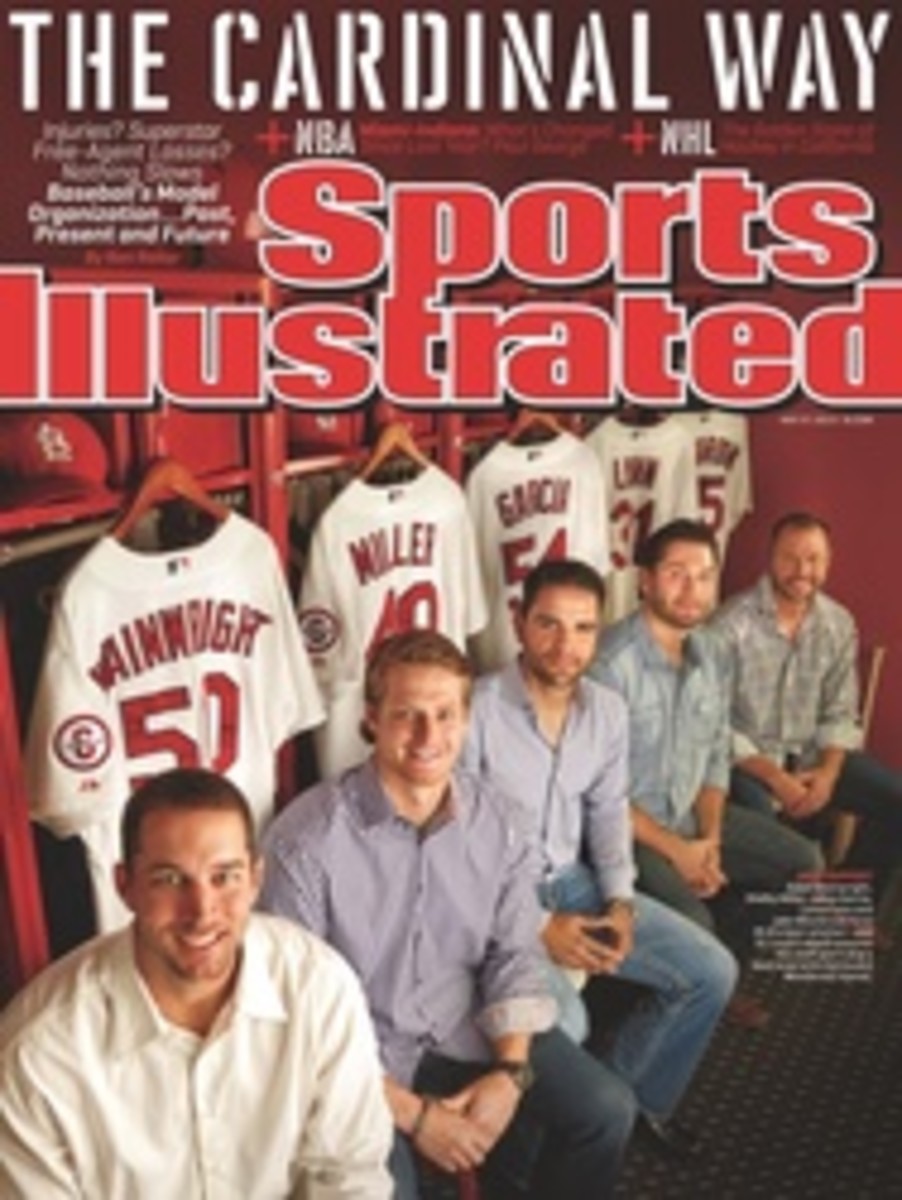
Life On the Farm
St. Louis has the best record in the National League, and, according to Baseball America, the No. 1--ranked minor league system, where the up-and-comers study the Cardinal Way
HANGING OUT in the cramped clubhouse at Memphis's AutoZone Park, a miniature version of Busch Stadium, is perhaps what it was like to chill out a few blocks away at Sun record studios when Elvis, Johnny Cash, Carl Perkins and Jerry Lee Lewis were jamming together. There's music blaring and half-dressed players mimicking swings and watching videos of opposing pitchers on their iPads. Outside, fans wearing red shirts with names of Cardinals greats of the past and present—MUSIAL, MOLINA, WAINWRIGHT—come for a glimpse of the future. Yet another wave of talented young Cardinals, headlined by outfielder Oscar Taveras (scouts call him Baby Vlad, as in Vladimir Guerrero), starting pitcher Michael Wacha (looking for the next Shelby Miller), and 2011 first-round pick Kolten Wong (a future batting champ at second base), is on the way. As a rival National League general manager said this spring of the young Cardinals talent, "It just keeps coming."
The red-brick yard at the corner of Union and South 3rd is the final proving ground for the finest minor league system in all of baseball. No organization is better at drafting and developing talent. Nineteen of the 25 players who took the field in last year's National League Championship Series for St. Louis were homegrown. "We realized long ago that free agency was not a place we wanted to be using our resources," says St. Louis G.M. John Mozeliak. "We decided that for us to have sustained success, we had to do it internally."
When it comes to draft picks, the Cardinals have a higher hit rate than the Biebs. Consider their haul of righthanded pitching from the 2009 draft alone. There is first-round pick Miller of Brownwood (Texas) High ("Him falling to us at the 19th pick was a surprise," says Mozeliak). And third-round pick Joe Kelly of Corona (Calif.) High ("Not a typical Cardinals draft pick, in the sense of being a high performer—he was just someone with a big arm"). And 21st-round pick Trevor Rosenthal of Cowley County (Kans.) Community College ("It shows you that when you have grinding away, you have the chance to discover a talent like this."). Miller is already a top of the rotation starter, while the 22-year-old Rosenthal and Kelly, 24, are key contributors out of the bullpen who project as starters.
In that same draft the Cardinals also landed two impact hitters who can play multiple positions. Thirteenth-round pick Matt Carpenter, 27, has split time at second and third base this year and has an .838 OPS; he also hit a key home run in Game 3 of last year's NLCS. First baseman Matt Adams, who has potential as an outfielder, is a lefthanded masher in the mold of Ryan Howard who had three homers and a 1.170 OPS in his first 42 plate appearances this season.
As the high-ceiling prospects wait in Memphis, they study the book on St. Louis's development philosophy. Upon signing with the organization, players receive a package in the mail that includes a shiny Cardinals jacket as well as an 86-page handbook called The Cardinal Way. It's both a meticulously detailed instructional guide (ex-pitching coach Dave Duncan contributed to the chapter on pitching, manager Mike Matheny the one on catching) and a crash course in the rich Cardinals tradition. "This organization is all about attention to detail—they hammer this stuff home constantly, and if you don't pay attention, someone's going to call you out," says Wacha. Before he arrived at his first training camp, in 2012, Wong had read the section for infielders and learned the nuances of the 12 different ground balls he might see. "If you have a question, you go to the book," he says. "It sounds cheesy, but you arrive at camp feeling like you're a part of something bigger than yourself."
Wong and Wacha could make major league cameos later this year; by 2014 they should be regulars in St. Louis. Taveras, the jewel of the system, is the x-factor for the Cardinals in '13. Mozeliak rarely makes lofty comparisons, but with the 20-year-old who was signed out of the Dominican Republic in '08 for $145,000, the G.M. doesn't hold back. "Over the last 15 years or so in St. Louis, I can only think of one man who's had a more prolific-looking bat at this time in his career, and that's Albert Pujols," he says. "He's an aggressive hitter with a really good trait: He hits the ball hard, and often."
This season, a year after winning Texas League MVP honors, Taveras has hit .317 with eight doubles and four homers in his first 31 games. Assuming free-agent-to-be Carlos Beltran leaves after this season, Taveras will be playing rightfield for the Cardinals every day next year. But his arrival could come sooner if they need a big lefthanded bat off the bench or an injury replacement in the outfield this summer.
Scouts liken Taveras to Guerrero for his ability to bludgeon baseballs that few others can get a bat on. During a recent game Taveras jumped on an 0-and-2 changeup out of the zone and ripped it over the rightfield wall. The players in the dugout asked him if it was a bad pitch. "Bad pitch?" Taveras said. "No, good pitch." Says Wong, "We watched the video afterward, and it was like three inches off the ground. It was impressive."
It was a glimpse of greatness. And like so much in Memphis these days, a glimpse of the future.
PHOTO
JEFF ROBERSON/AP (TAVERAS)
KIDDIE POOL Top prospect Taveras (above), a.k.a. Baby Vlad, will likely start in rightfield next year, while Carpenter, a graduate of the farm system, is already contributing as a hitter and utility infielder.
PHOTO
STEVE MITCHELL/USA TODAY SPORTS (CARPENTER)
[See caption above]

